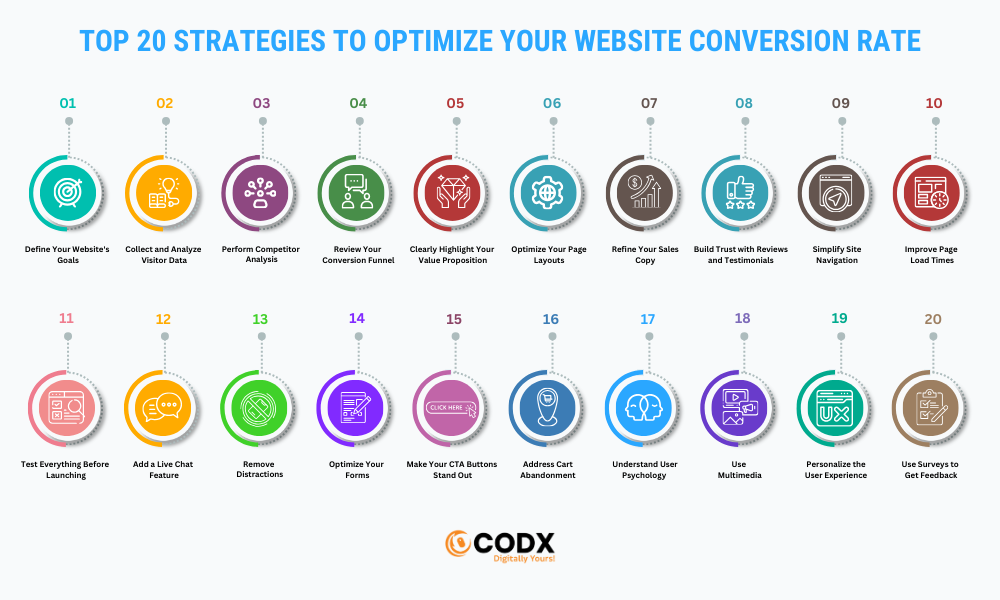Conversion rate optimization (CRO): Implement strategies to improve conversion rates and increase sales
CRO, or Conversion Rate Optimization, is all about getting more people who visit your website to actually do what you want them to do, whether it’s buying something, signing up for a newsletter, or contacting you.
Instead of spending a lot of time and money trying to get more people to visit your site, CRO helps you get more value out of the people who are already there.
In this guide, we’ll explain CRO in simple terms and give you some easy tips to help you improve your website’s results.
Why Conversion Rate Optimization is important ?

A higher conversion rate means more business for you. When more of your visitors become paying customers, you’ll see a boost in revenue. It’s pretty straightforward.
But it’s not just about making more money. CRO is also about improving the user experience on your site. By testing and tweaking different parts of your website, you can create a smoother, more enjoyable experience for your visitors. This keeps them engaged and makes them more likely to stick around.
In today’s crowded online space, having a website that converts well is crucial. It gives you an edge over your competition and helps you stand out.
If you want your online business to succeed, paying attention to your conversion rate and working on improving it with CRO is key.
Where to Implement a Conversion Rate Optimization Strategy
There are many areas on your website where you can apply a Conversion Rate Optimization (CRO) strategy, but some spots can have a bigger impact than others. Here are a few key places you should focus on to boost your conversion rate:
- Landing Pages: Landing pages are often the first thing visitors see, so they play a big role in whether someone takes action or leaves. By optimizing these pages, you can improve the user experience and make it more likely that visitors will become customers.
- Call-to-Action (CTA) Buttons:CTA buttons are what encourage visitors to take the next step, whether that’s signing up, buying something, or learning more. Make sure your CTAs are clear, easy to find, and persuasive to increase the chances that people will click.
- Checkout Process: If you sell products or services, the checkout process is one of the most important parts of your site. A simple, hassle-free checkout can lead to more completed purchases and fewer abandoned carts, boosting your conversion rate.
- Product/Service Pages:These pages are where people decide whether or not to buy from you. By providing clear, detailed information, you can build trust with your visitors and help them feel confident in their decision to buy.
Every website is different, so it’s a good idea to test other areas as well and see what works best for you. Keep experimenting, and you’ll find ways to improve your results!
Top 20 Strategies to Optimize Your Website Conversion Rate

1. Define Your Website’s Goals
Before you begin optimizing your conversion rate, it’s essential to define clear goals for your website. These goals represent the actions you want visitors to take, such as filling out a form, clicking on a link, or making a purchase. Having clear goals lets you track visitor behavior and see what’s working or where you can improve.
Some common goals to optimize for include:
– Page visits
– Form submissions
– Link clicks
– Specific element clicks
– Custom conversions
- Collect and Analyze Visitor Data
When improving your website, rely on data, not guesswork. A proven way to increase conversions is by consistently tracking and analyzing your website data to understand your visitors’ behavior and preferences.
Some key data points to focus on include:
– Website traffic and traffic sources
– User behavior on specific pages
– Bounce and abandonment rates
– Click-through rates for ads and campaigns
– Data on returning customers and average order values
– Feedback from users, such as Net Promoter Scores (NPS)
Once you have this information, create a “user persona,” a profile that represents your ideal visitor. This profile includes their interests, goals, and pain points, helping you design a website that meets their needs.
- Perform Competitor Analysis
To stay ahead of your competition, it’s important to know their strengths and weaknesses. By analyzing your competitors, you can identify what sets your business apart and highlight your unique selling points (USPs). This also helps you understand what potential customers might be comparing when deciding between you and your competitors.
Performing a competitor analysis allows you to see your website from a customer’s point of view, helping you optimize your site to stand out.
- Review Your Conversion Funnel
To fix what’s not working, you need to understand your current user journey and conversion funnel. Where are visitors hesitating or dropping off? Using tools like VWO Insights, you can track each stage of the funnel and identify where visitors lose interest, allowing you to make improvements.
For example, many eCommerce businesses focus on optimizing the checkout process, as nearly 70% of shoppers abandon their carts at this stage. Even small improvements to this part of the funnel can significantly boost your conversion rate.
- Clearly Highlight Your Value Proposition
Your value proposition is a brief explanation of why someone should choose your product or service over a competitor’s. It’s essential to clearly communicate this on your website to encourage visitors to take action.
Your value proposition should be reflected in your headlines, images, and copy. A good example is Evernote’s evolution of their tagline from “Remember Everything” to a more functional and descriptive phrase that better highlights the tool’s benefits.
- Optimize Your Page Layouts
If you’re not seeing an improvement in conversion rates despite trying multiple strategies, it might be time to rethink your page layouts. By using data from tools like heatmaps or scroll tracking, you can gain insights into how users are interacting with your pages and make adjustments accordingly.
Optimizing layouts can make your site more user-friendly, increasing engagement and conversions.
- Refine Your Sales Copy
Your sales copy can make or break your conversion rate. Start by refining your headlines, as this is the first thing visitors will see. A strong headline can make a big difference in engagement. Testing different variations of headlines, like the one done by imsider.ru, can lead to improvements in conversion rates.
- Build Trust with Reviews and Testimonials
Trust is key to conversions. Featuring customer reviews and testimonials can significantly boost your credibility and encourage visitors to take action. Sharing customer success stories, complete with photos and company logos, is a great way to build trust.
Research shows that visitors who engage with reviews are 58% more likely to convert into paying customers.
- Simplify Site Navigation
Your website should be easy to navigate. If visitors can’t find what they’re looking for quickly, they’re likely to leave. Make sure your site’s navigation is intuitive, user-friendly, and seamless. Consider adding a search feature to further help visitors find what they need easily.
- Improve Page Load Times
Slow-loading pages can drive visitors away. Research suggests that a page load time of more than four seconds leads to higher abandonment rates. Optimizing your site’s speed by reducing large images or using Accelerated Mobile Pages (AMPs) can help improve your conversion rate.
- Test Everything Before Launching
One of the best ways to ensure your website improvements are effective is to test them first. A/B testing, for example, allows you to compare different versions of your pages to see which one performs better. Relying on actual user behavior instead of assumptions ensures that the changes you make positively impact conversions.
- Add a Live Chat Feature
A live chat feature can guide visitors through your site, helping them find what they need without getting frustrated. This can reduce bounce rates and increase conversions by providing real-time assistance when visitors have questions.
- Remove Distractions
Avoid cluttering your web pages with unnecessary information. Streamline your content and focus on key elements like product details and calls-to-action (CTAs). For example, PearlsOnly simplified their checkout page by removing distractions, which increased their revenue by 10%.
- Optimize Your Forms
Complicated forms can drive visitors away. To improve form completion rates, reduce the number of fields, use inline validation, and display helpful error messages. Simplifying forms has been shown to significantly increase conversions.
- Make Your CTA Buttons Stand Out
Your call-to-action (CTA) buttons play a huge role in driving conversions. Make sure they are clear, engaging, and stand out from the rest of the page. A slight tweak in the wording or design of your CTA can lead to significant improvements in engagement and clicks.
- Address Cart Abandonment
Cart abandonment is a common issue, especially for eCommerce sites. Implement strategies like reminder emails, streamlined checkout processes, and re-engagement techniques to recover lost sales and reduce abandonment rates.
- Understand User Psychology
Understanding the psychological principles behind user behavior can help you design a website that aligns with visitors’ expectations. For example, decluttering your website and providing proof of trust (like testimonials) can significantly improve conversions.
- Use Multimedia
Adding multimedia elements like videos and images can make your content more engaging and memorable. For example, adding product demonstration videos or virtual property tours can increase engagement and drive conversions.
- Personalize the User Experience
Personalizing the user experience can lead to higher conversion rates. Tailoring product recommendations or showing personalized offers based on visitor behavior helps create a more relevant experience for each visitor.
- Use Surveys to Get Feedback
Visitors can provide valuable feedback on their experience with your site. Use surveys to understand what’s working well and where improvements are needed. With the insights gained, you can refine your website and address any pain points visitors encounter.
Conclusion
Improving your website’s conversion rate is a simple way to get more from your marketing efforts. The more visitors you turn into customers, the better it is for your business. But raising conversion rates isn’t just about quick fixes—it’s about having a clear plan.
Remember, though, not every strategy will work the same for every business. What matters most is setting clear goals, understanding your audience, and testing to see what works best.
By trying these Strategies and making small adjustments along the way, you’ll likely see your conversion rates go up, helping your business grow and stand out from the competition.
As an award-winning agency, Codx takes pride not just in the digital solutions we offer our partners but also in our advisory expertise.
We are here to help you create the perfect plan for your exciting new business venture. Whether you are just starting out or considering the idea, we’ve got you covered.
Contact us today and let’s discuss how we can develop a customized metaverse strategy to position your brand for success in the e-commerce revolution!
Book your free consultation now.
- 46 views
- 0 Comment


